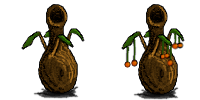Spludd is a plant-like organism that produces a fruiting body commonly consumed as a food. The exact origins of spludd are obscure, it likely originated among the old core worlds of the Empire of 1,000,000 Suns, where it is a popular food.
The fruiting body of spludd contains small seeds that are normally eaten with the flesh of the fruit. The spludd fruit (simply called spludd), is reminiscent of bread, of pudding and of meat, combining the textures of all three. It has a unique sweet and savory flavor and is high in both protein and short-chain carbohydrates.
Humans first encountered spludd on New Promise in the hills northwest of New Denver. Archaeological findings in the area suggest that the Convergence had been in that region sometime before humans first arrived in GSC 130.
Life Cycle
Spludd grows from a seed, like most plants. Upon sprouting it first grows leaves and a short stalk, then develops the fruiting body. The juvenile fruiting body is covered in a sweet nectar and pollinated directly by insects without going through the flower stage typical of most plants.
A spludd bud, at this early phase of development the fruiting body is considered inedible due to high levels of tannins.
A more mature fruiting body, this one is not quite fully ripe, but getting close.
The spludd fruit right after harvest.
After cleaning and preparation. Spludd can be eaten raw, or cooked into a wide variety of dishes.
A popular recipe featuring spludd as the main ingredient is this sweet and spicy cake.
Pictures made with ArtBreeder.
















